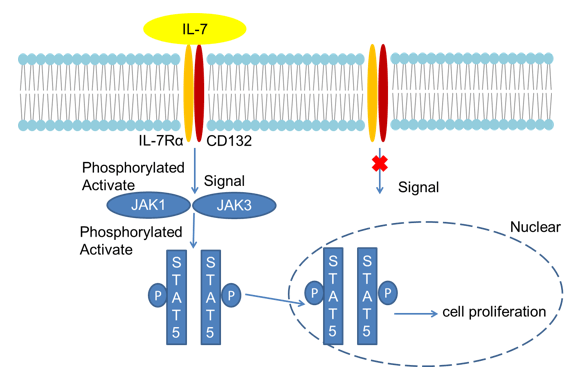Introduction
Interleukin-7 (IL-7) is a multi-effect cytokine secreted by bone marrow and thymic stromal cells, and belongs to a cytokine of the chemokine family. IL-7 plays an important role in the development, proliferation, differentiation and immune self-stabilization of T cells. It also plays a role in the development and maturation of B cells and the prevention of thymus aging. In addition, IL-7 is closely related to the occurrence of viral infectious diseases, asthma and autoimmune diseases, tumors and immune aging.
Mechanism and Function
IL-7 is a single-chain glycoprotein composed of 152 amino acids and contains 4 alpha helices cross-linked by disulfide bonds. It can be secreted extracellularly or expressed on the cell surface. The human IL-7 gene is located on chromosome 8 and encodes a gene of 1589 bp. It contains 6 exons and 5 introns. Human and mouse IL-7 have 81% homology. The biological effect of IL-7 is mainly achieved through the binding of IL-7 to the IL-7 receptor (IL-7R). IL-7R is a heterodimer composed of IL-7Rα (CD127) and a common γ chain (CD132, IL-2RG). The common γ chain is shared by multiple receptors. IL-17 mainly relies on JAK / STAT5 signaling pathway to maintain the survival status of T cells by regulating the expression of BCL-2 protein family. After IL-17 first binds to IL-17R, it triggers the activation of IL-17R-associated tyrosine kinase 1 (JAK1) and JAK3 in the cell. The activated JAK protein phosphorylates a specific motif located on the IL-17Rα chain to form a binding site, which can be used for the signaling molecule STAT5 containing the Src homolog 2 (SH2) domain to bind to phosphorylated STAT5, causing STAT5 to form dimerization The body enters the nucleus and regulates a series of genes for cell growth and survival in the nucleus, including up-regulating anti-apoptotic proteins in the BCL-2 protein family, down-regulating pro-apoptotic proteins, and promoting T cell survival in vivo.
The target cells of IL-7 are mainly lymphocytes, which have growth-promoting activity on B progenitor cells, thymus cells and peripheral mature T cells from human or mouse bone marrow. IL-7 and stem cell growth factor (SCF) can synergistically stimulate the mitosis of precursor b, this effect can be inhibited by tgf and; however, it has no obvious effect on the growth of progenitor b (pro-b). IL-7 promotes the maturation of double-negative thymocytes and provides the initiation signal of tcr gene recombination during the development of embryonic thymocytes; however, it has no obvious effect on mature T cells. IL-7 induces thymocytes or peripheral blood lymphocytes to produce LAK cell activity. However, IL-7 induced LAK cells do not have NK activity. IL-7 can stimulate myeloid precursor cells and megakaryocytes to produce colony forming units and platelets. At higher concentrations, IL-7 can also enhance the cytotoxic activity of macrophages and induce monocytes to secrete cytokines.
 Fig 1. Mechanism of Signaling
Fig 1. Mechanism of Signaling
Creative Proteomics can provide cytokine detection platform for scientific research. According to different purposes, our dedicated analysts will customize exclusive solutions for you. We aim to provide customers with high-quality and convenient services to help you accelerate the progress of your project.
Our cytokine detection service includes but is not limited to:
- One or more cytokines qualitative and quantitative detection
- Cytokines qualitative and quantitative detection of various species
- Cytokine antibodies qualitative and quantitative detection
Sample requirements
- Sample Types-Blood, serum, plasma, cell culture medium, tissue homogenate, etc.
- Sample Volume - It is optimal for 50 samples. This volume allows for triplicate testing of each sample.
Our advantages:
- Different detection methods can be selected based on different samples and requirements.
- Ensure the specificity and accuracy of the test by using high quality antibodies.
- Repeat the test to ensure the repeatability and accuracy of the experimental results.
- Feedback results are accurate and efficient.
Technology platform:
We mainly provide the Luminex cytokine detection platform. Luminex uses fluorescently encoded microspheres with specific antibodies to different target molecules. The different microspheres can be combined freely to a certain extent so that up to 100 analytes can be tested multiple times simultaneously in a single experiment.
The Luminex cytokine assay platform has the following advantages:
- Multiple detection: simultaneous detection of 100 biological targets
- Short experiment time: 1-3 weeks
- High sensitivity: the lower limit of accurate quantification is as low as 0.1 pg/mL
- Save samples: only need a sample volume as low as 25 μL
- Time saving: the experiment process only takes 4 hours
For your different needs, we can also provide the following detection methods:
- Enzyme-linked immunosorbent assay (ELISA)
- Flow cytometry
Workflow

For more information about the IL-7 detection service or need other detection requirements, please contact us.
References:
- Liu X, et al. Crucial role of interleukin-7 in T helper type 17 survival and expansion in autoimmune disease. Nat Med, 2010, 16(2):191-197.
- Kim GY, et al. Seeing is believing : illuminating the source of in vivo interleukin-7. Immune Netw, 2011,11(1):1-10.



